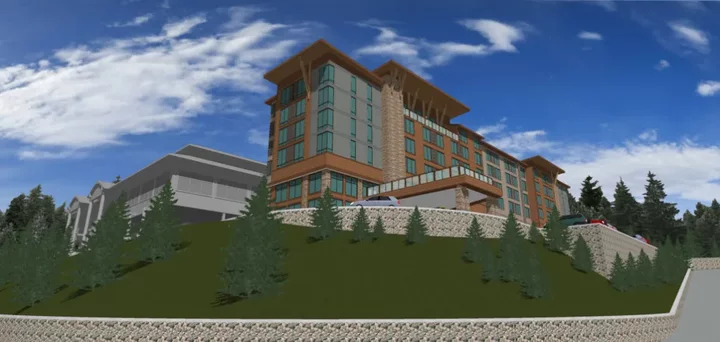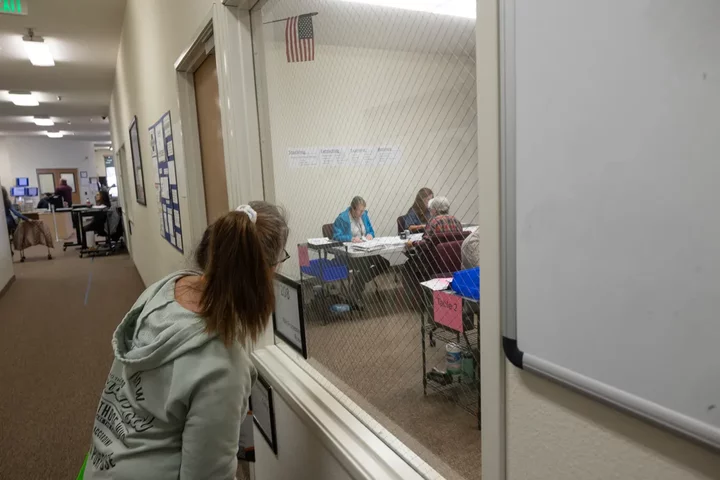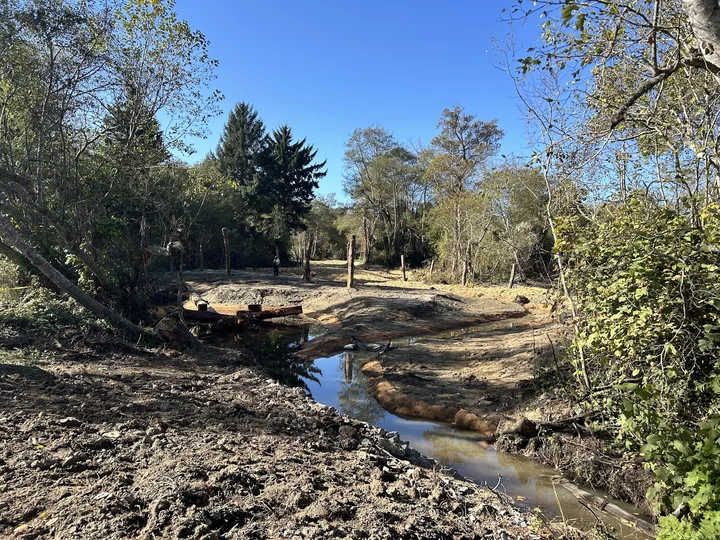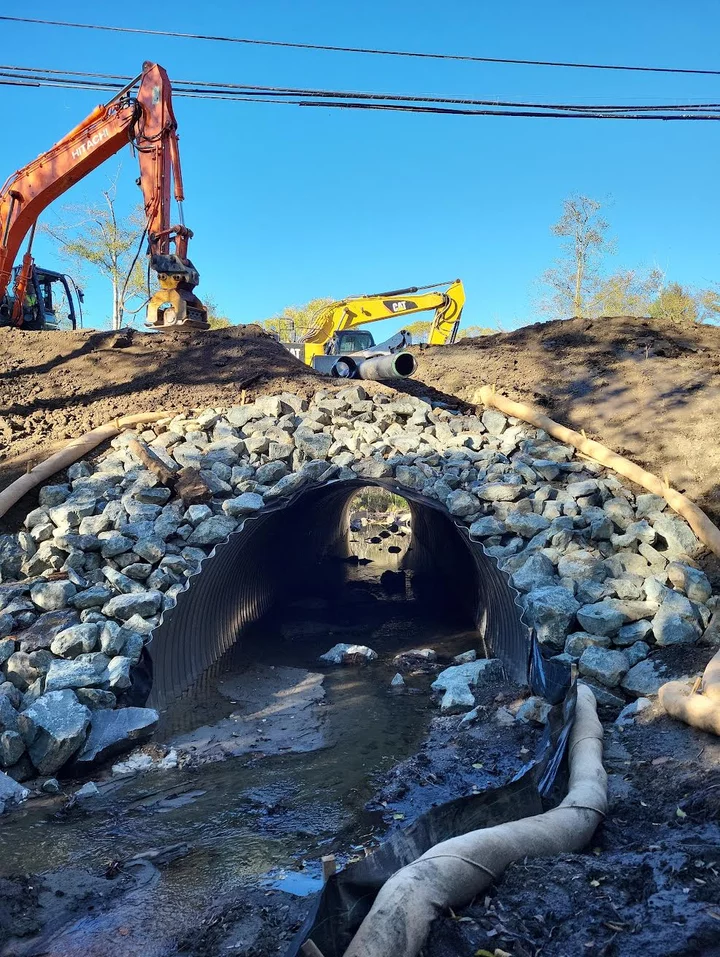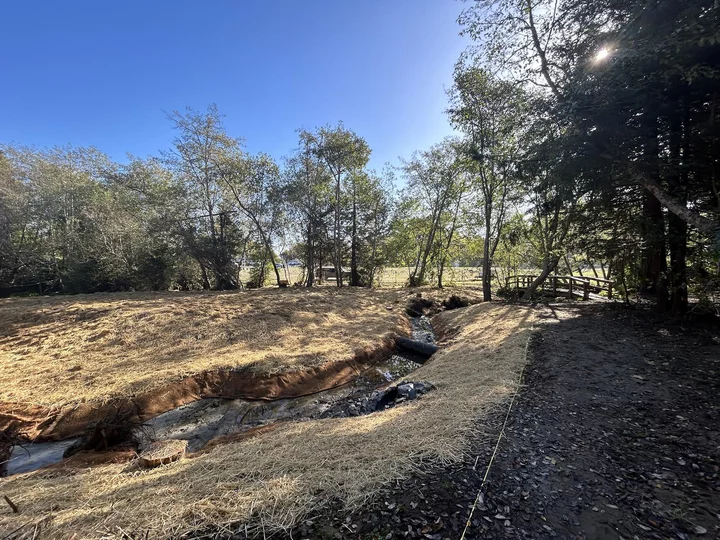OBITUARY: John Nunes, 1957-2024
LoCO Staff / Saturday, Nov. 2, 2024 @ 6:56 a.m. / Obits
John
Nunes, a beloved figure in the Ferndale and Fortuna community, passed
away peacefully on the morning of October 20th, 2024, at 10:25 am,
walking into a friend’s home with the usual smile on his face,
preparing to cheer on his undefeated Minnesota Vikings. He was 67
years old. John was born on August 29th, 1957, to Tony and Velma
Nunes and was the sixth of ten children.
A proud Ferndale Wildcat, John excelled in football, track, and basketball. After high school, he carried on his family’s legacy at the Beatrice Dairy, following in the footsteps of his father and grandfather as a dairyman. John’s passion for gardening, especially garlic, earned him the affectionate title of “Garlic Guru.” He also enjoyed horseracing and had a knack for picking winners. His wife’s Uncle Frank always said John’s racing tips made the betting machine better than an ATM.
His greatest love was the “littles” in his life. His daughter and stepson, his two cherished “grands,” 24 special nieces and nephews, their spouses and significant others, and his 11 little “greats” brought him immense joy.
John was a loving husband, father, Pop, brother, brother-in-law, uncle, and friend to many. He is survived by his wife, Ginger, daughter Michelle, grandson Faris, stepson Brian (Nikki), and granddaughter Jessi. He is also survived by his siblings: Mike (Jeanine), Steve Ruth), Sheila (Steve); Blake (Johnna), Sherry (Paul); Andrew (Jennifer), Shelly (Lonnie) and brothers-in-law: Tony (Janice) and Richard.
John was preceded in death by his parents, Tony and Velma Nunes, brothers Anthony and David Nunes, mother and father-in-law, Tony and Gerry Leonardo, and sister-in-law Tina.
A Celebration of Life for John will be held on Sunday, November 10th, at 10:25 AM at the Portuguese Hall in Ferndale.
###
The obituary above was submitted on behalf of John Nunes’ loved ones. The Lost Coast Outpost runs obituaries of Humboldt County residents at no charge. See guidelines here. Email news@lostcoastoutpost.com.
BOOKED
Today: 11 felonies, 9 misdemeanors, 0 infractions
JUDGED
Humboldt County Superior Court Calendar: Today
CHP REPORTS
Us101 N / Sr255 Ofr (HM office): Trfc Collision-1141 Enrt
Sr299 / Glen Rd (RD office): Assist CT with Maintenance
ELSEWHERE
Governor’s Office: Hawaii to join West Coast Health Alliance with California, Oregon, and Washington
The Hill: GOP lurches toward shutdown as Democrats vow they won’t be rolled
The Hill: No joke: Comedian Graham Linehan arrested in Britain for quip about trans women
Local Fishermen Call for Improvements at Eureka’s Public Marina as Silt Build-Up Renders Boat Ramp Nearly Impassable
Isabella Vanderheiden / Friday, Nov. 1, 2024 @ 4:36 p.m. / Infrastructure , Local Government
Eureka’s public boat launch facilities need a good dredging. The boat ramp has become inundated with silt in recent years, leaving one lane nearly impassable. | Photo: Andrew Goff
###
The local fishing community is sounding the alarm over ongoing maintenance and safety issues at the Eureka Public Marina and boat launch facilities, near the Wharfinger Building on Waterfront Drive.
Over the years, the two-lane boat ramp has become inundated with mud, leaving one lane nearly inaccessible, according to Kent Hulbert, vice chair of the Humboldt Harbor Safety Committee and director of the Humboldt Area Saltwater Anglers (HASA).
“There’s two boat launch lanes but only one is useable on a regular basis because [the other one] gets silted in and collects seaweed,” Hulbert told the Outpost. “It’s not dredged very often and the mud is so thick you can’t launch a large boat without worrying about touching the bottom, especially on a low tide. A lot of the time people don’t want to back their vehicle down into the mud [because] they don’t want to get their boat stuck down there.”
Many of our readers will remember what happened several years ago, when the marina became so inundated with mud and gunk that docked boats would run aground every low tide, rendering them useless for hours at a time. The government agencies tasked with dredging responsibilities bickered over how to dispose of the sludgy stuff for years before eventually agreeing in 2017 to tow it out to the Humboldt Open Ocean Dredging Site (HOODS), a square-shaped patch of sea located approximately three miles offshore. Eureka’s Public Marina hasn’t been dredged since.
The Eureka Public Marina pictured in 2016. Photo: Bob Oglesby
The city had plans to join the Humboldt Bay Harbor, Recreation and Conservation District’s dredging operation earlier this year, but those plans fell through when a staffer with the Environmental Protection Agency (EPA) informed Eureka City Manager Miles Slattery that the city was required to do additional testing.
“There’s a new employee at the EPA that has a different viewpoint about the sampling that needs to be done in order to dredge,” Slattery told the Outpost. “During previous dredge cycles, we’ve always done chemistries where we take sediment samples and test for dioxin, metals, PCBs and other constituents. Once that’s cleared, you can go dredge. We did that, but this employee at the EPA feels as though we need to do toxicity tests.”
In years and decades past, the city has sourced geological data from the U.S. Army Corps of Engineers, the agency responsible for maintaining federal navigation channels in Humboldt Bay, but it seems the EPA has modified its testing standards.
[CLARIFICATION: In 2022, the State Water Resources Control Board adopted new Aquatic Toxicity Provisions to bolster protections for aquatic life in enclosed bays and estuaries. The provisions were approved by the EPA in 2023. The testing requirement is a statewide requirement to protect water quality and aquatic organisms.]
“The previous EPA employee didn’t require toxicity tests because we used data that was gathered by the U.S. Army Corps of Engineers, which is in close proximity [to the marina],” Slattery said. “There hasn’t been any new industry within the bay or any spills that would cause any toxicity issues. However, this EPA employee decided to have us do the test, which made us miss the window to utilize the same bid process that the Harbor District did. Our plan is to go out and dredge next year.”
“Our boat launch is just fine,” he added. “It’s still usable, it’s just a matter of timing the tide.”
However, that’s not the only issue at the marina. Pamyln Hentz Millsap, an avid fisher and retired Eureka Police Department homeless liaison, has seen an uptick in abandoned vehicles parked in the marina parking lot and along Waterfront Drive.
“The parking lot is a nightmare because there aren’t many parking spaces. People towing boat trailers often don’t even have a place to park because abandoned vehicles are parked there,” Millsap told the Outpost. “A lot of the vehicles can’t be moved because they’re broken down and people are living in them. It looks like a dump.”
The public bathrooms are also a problem. The bathrooms are often locked, and when they are open they’re “nasty,” Millsap said. On two occasions she’s encountered people “shooting up” and sleeping on the bathroom floor.
“Homeless people don’t scare me because I’ve worked with them so long but I’ve heard other people complain,” she said, noting that she helped form the county’s Mobile Intervention Services Team (MIST), which serves homeless people experiencing mental health crises. “I’m not trying to be mean, you know? I worked with the homeless community for years when I was at EPD. That population has a big piece of my heart.”
Asked what EPD and the city could do to alleviate the issue, Millsap thought for a moment before saying, “You know, I don’t know.”
“I’ve contacted [EPD’s Community Safety Engagement Team] CSET and said, ‘Hey, can you guys do something about this?’ but their hands are often tied due to different laws,” she continued. “I just think this [portion of the waterfront] is a forgotten area. … It seems to be a really handy spot where people can park their vehicles and stay out of sight of downtown business owners. … Everybody is trying to do what they can, but it’s not a good situation.”
Millsap and Hulbert both felt the city should do more to maintain and, ideally, update the public facilities at the marina. While commercial fishing has declined over the years, it’s still a significant part of Eureka’s identity and a big draw for people visiting the region, Hulbert said.
“I just don’t think the city has prioritized it,” he continued. “You know, people come a long way to go tuna fishing or crabbing up here. Those people are spending money here. They’re staying in our hotels and paying into the transient occupancy tax (TOT). And I don’t think they’re getting their money’s worth because our facilities aren’t up to par. … It’s kind of embarrassing that Crescent City had a much better facility than we do.”
A new fish-cleaning station would make a huge difference. There’s an existing fish-cleaning station down on the dock, but it’s “not really useable,” Hulbert said.
The problem: High-quality fish-cleaning stations are really expensive. If the city were to purchase a new fish-cleaning station, Slattery said it would have to be equipped with an industrial grinder to break down the fish carcasses.
“It’s so cost-prohibitive to deal with the carcasses,” he said. “If Pacific Choice were still processing shrimp, that would have been a viable option for those carcasses because they could have gone into their shrimp waste, which is sold for other products. But, unfortunately, they stopped processing shrimp.”
The city is partnering with a few local fishermen to start a waterfront fish market, though it’s still in the early stages. “If that happens, there would be a fish-cleaning station there,” Slattery said.
If it’s an issue of funding, Millsap said the city could impose a parking fee at the marina.
“Crescent City, Brookings, Charleston, and many of the other places charge people to park in certain areas,” she said. “I think it’s maybe $5 or $6 a day in Crescent City. I know that might aggravate people but I think that money could be used for upkeep on the bathrooms and the dock, which are often in disarray. I don’t think any of us would object to paying a daily, or even a yearly payment to park there if [the facilities] were decent and the upkeep was decent.”
Slattery said that’s something the city would be willing to look into as part of the “bigger picture” for the waterfront, but said it wouldn’t generate enough revenue to cover the cost of big projects like dredging.
###
[NOTE: A previous version of this story incorrectly identified Millsap as a retired EPD police officer. We also incorrectly stated that she helped form CSET. The Outpost regrets the error.s]
Pandemic-Era Killer Given Four Life Sentences But Will be Eligible for a Parole Hearing in 25 Years, DA’s Office Says
LoCO Staff / Friday, Nov. 1, 2024 @ 4:21 p.m. / Courts
Press release from the Humboldt County District Attorney’s Office:
Today, Judge Lawrence Killoran sentenced Wesley Lee Starritt, age 26, to serve four life sentences in prison for the murders of Mr. Roger Mitch Clark on May 18-19th, 2020, Mr. Charles LeVaugh on December 4th, 2017, and the attempted murders of Bryon Tatum on April 20th, 2020, and Ciuleandra Smith on May 13th, 2020. Each of his victims were strangers to Mr. Starritt.
In sentencing Mr. Starritt, Judge Killoran stated, “There are no words. These killings are inexplicable, cowardly, monstrous; and … all I could think was even these adjectives don’t describe it well enough. It doesn’t really capture how truly horrendous these actions were. And, unfortunately, … I find nothing redeeming at this time in the defendant or his character…. So, as I was kind of struggling in deciding what it was that I would say to all of you today, I thought, really, at the end of the day, I would just mention those folks who lost their lives, what excellent community members they were, how greatly they would be missed and … focus on the two men who lost their lives and just being thankful that the defendant was not successful as to Bryon Tatum and Ms. Smith and the attempted murders of those individuals.”
Mr. Levaugh’s sister, Charlotte LeVaugh-Paul, addressed the judge prior to sentencing and described her brother as a generous man who was always helping others, stating, “My brother was a good man[,] he was kind to everyone.” Charlotte detailed the effects that the loss of her brother has had on her family, including her mother, who unfortunately passed away before she could see Mr. Starritt sentenced.
Mr. Clark’s son, Mitchell Clark, and niece, Kimberly Perris, addressed the profound loss to their family at the hands of Mr. Starritt. Mitch recalled his father’s service in the armed forces, and his dedication as a Los Angeles County Sheriff’s Deputy. But Mitch’s description of his father’s contributions to Eureka and Humboldt County demonstrates how this loss has affected everyone: “He was a member of the Eureka community for over 50 years, and a local business owner until his retirement just a few years ago… He gave generously to many charities, both locally and nationally. For example, he bought bicycles for local under privileged children at Christmas every year. He was a wonderful, generous man who did not deserve to die this way.”
Kimberly described her uncle and aunt (who predeceased him): “…They worked tirelessly, investing in their business’s success, and dedicated to supporting their employees. Though they led simple, frugal lives personally, they were remarkably generous to others, giving to many causes they believed in. One example of their compassion was their annual support of Toys for Tots, to which they contributed money and toys to children in need…. Uncle Mitch was known for his vivid childhood memories and his knack for storytelling. Though gruff on the outside, he had a huge heart and cherished his family deeply.”
The investigation of each of these cases was led by the Eureka Police Department, with assistance from the Eureka Problem Oriented Policing Team and the Humboldt County Drug Task Force. Without the hard work of the detectives, patrol officers, and forensic technicians at the Eureka Police Department, these crimes wouldn’t have been linked together so quickly and a suspect identified and arrested. The case was prosecuted initially by District Attorney Stacey Eads, and later by Deputy District Attorney Roger Rees, with assistance from District Attorney Investigator Rick Bise and Victim Advocate Michala Pelran, among others.
Mr. Starritt waived his right to appeal any aspect of his sentence, and because he was convicted of murder, he will have to serve every day of his sentence. Under California law, Mr. Starritt will be eligible for a parole hearing after he has served 25 years of his life sentence.
###
PREVIOUSLY:
- Eureka Police Arrest ‘Person of Interest’ in Last Week’s Campton Road Homicide Investigation
- Criminal Proceedings Against Campton Road Murder Suspect Delayed After Attorney Questions His Mental Competence
- (VIDEO) Eureka Police Department Holds Press Conference on Campton Road Murder Investigtion
- Two Jail Staff Members Assaulted Over the Weekend, Says Sheriff’s Office; Overall Inmate Attacks on Jail Personnel Way Up This Year
- Suspect in Eureka Murder, Two Other Recent Stabbings Ruled Mentally Incompetent to Stand Trial
- Eureka Murder Suspect’s Mental Competance Will Be Re-evaluated
- EPD Believes They’ve Figured Out Who Stabbed a Homeless Man to Death in 2017
Trinidad Rancheria’s Proposed Hyatt Hotel Project Dealt Setback as Appeals Court Issues Tentative Ruling Finding Insufficient Evidence of Adequate Fire Protection Services
Ryan Burns / Friday, Nov. 1, 2024 @ 4:06 p.m. / Courts , Tribes
Rendering of a proposed five-story, 100-room Hyatt hotel proposed on the bluff adjacent to the Cher-Ae Heights Casino, overlooking the Pacific. | Image via California Coastal Commission.
###
Long-gestating plans from the Trinidad Rancheria to build a five-story, 100-room Hyatt hotel on the bluff above Scenic Drive were dealt a blow yesterday by a California appeals court’s tentative ruling, which says there’s insufficient evidence that the hotel would have adequate fire protection services.
If the tentative ruling is finalized it would reverse a conditional determination made by the California Coastal Commission way back in August 2019. With a narrow 6-5 vote, the commission agreed with the federal Bureau of Indian Affairs (BIA), which had found the project consistent with the state’s Coastal Act. However, the Coastal Commission said the Tribe would need to find an adequate water supply, which had proved difficult for the Tribe.
With yesterday’s tentative ruling, Justice Mark B. Simons, of California’s 1st District Court of Appeal, scheduled oral arguments for Nov. 21. If the Coastal Commission or any other parties, including the Trinidad Rancheria, want to make a case against this preliminary opinion, they’ll be given 10 minutes apiece to do on that date.
The appeal of the Coastal Commission’s 2019 decision was filed by the Humboldt Alliance for Responsible Planning (HARP), a nonprofit group focused on development issues in the Trinidad-Westhaven area. A trial court denied HARP’s petition, but the group appealed on five separate grounds, challenging the reasoning and foundations of the commission’s actions on a variety of matters, including the look of the hotel — whether it would fit in with its scenic surroundings.
A visual simulation of the proposed hotel at the Trinidad Rancheria from the water below. | Image via California Coastal Commission.
Justice Simons rejects all but one of those arguments in his tentative opinion — the one saying there’s no substantial evidence to support a finding of adequate fire protection services for the proposed hotel.
“[W]e agree with HARP that there is insufficient evidence to support that finding,” Justice Simons says.
During the 2019 hearing, Coastal Commission staff pointed to cooperative agreements with surrounding fire service providers, including the Trinidad and Westhaven volunteer fire departments and CalFire, which has a station nearby. But staff also noted that the closest hook and ladder equipment was in Arcata.
The services closer to the proposed hotel, including those from the nearby CalFire station, are equipped to handle residential fires but not blazes in a multi-story hotel.
Rancheria CEO Jacque Hostler-Carmesin “acknowledged that the closest ladder truck was in Arcata,” Simons notes, but she then pushed back on the commission — and on local Commissioner Mike Wilson, in particular — arguing that the commission was “really questioning the tribe’s integrity.”
Hostler-Carmesin added, “for insurance reasons, we have fire hydrants, we have fire protection … we do everything right … and the building will have sprinkler systems, all of that.”
Wilson and the rest of the commission backed off, but Simons observes that, “The revised findings made no mention of fire protection services.” His tentative ruling says that because HARP raised its concerns in a timely manner “and because the adequacy of fire protection services is an important public safety issue, we exercise our discretion to consider it here.”
Ultimately, his tentative ruling comes down to a sort of technicality. He says that the commission’s finding that there are adequate fire protection services is reasonable, “But we further conclude that there is insufficient evidence to support that finding.”
Simons notes that the Tribe only said it has “preliminary agreements, verbally with CalFire” but also acknowledged that “[w]e haven’t circled back to CalFire.”
“Although we do not doubt the sincerity of the Tribe’s representations or intentions, this vague assertion of a preliminary, verbal agreement with CalFire simply does not constitute substantial evidence of adequate fire protection services,” Simons writes.
The Outpost reached out to HARP, the Coastal Commission and the Trinidad Rancheria earlier today. A member of HARP did not respond to our email before this post was published.
Reached by phone, Hostler-Carmesin said she had no idea that anything like this had been filed in court. She declined to comment any further on the record, saying she’ll send us an official statement in the near future.
The Coastal Commission did not immediately provide responses to an emailed list of questions, though spokesperson Joshua Smith said he’ll try to get replies by early next week.
We will report more on this issue once we hear back from the above-mentioned folks.
###
###
PREVIOUSLY
- Take a Look at the Big Proposed Trinidad Casino Hotel; Concerned Community Members Schedule Meeting to Gin Up Public Comment
- Coastal Commission Gives Green Light to 100-Room Hotel on Trinidad Rancheria … as Long as the Tribe Can Find a Reliable Water Supply
- That Coastal Commission Meeting Was a Confusing Mess. Did They Even Mean to Advance the Hotel Project?
- The City of Trinidad and the Trinidad Rancheria Are at Odds Again Over the Water Supply for the Tribe’s Hotel Project
- City Pumps Brakes on Trinidad Rancheria’s Request for Water; Will Draft Policy Before Continuing Formal Negotiations Over New Hotel Development
- Trinidad Rancheria Asks for Pipeline Extension to Get Water Via Humboldt Bay Municipal Water District
Election Workers Quit in Shasta as Self-Appointed Observers Roam Office
Sergio Olmos / Friday, Nov. 1, 2024 @ 1:15 p.m. / Sacramento
An election observer watches as workers process ballots at the Shasta County Clerk Registrar of Voters office in Redding on Oct. 30, 2024. Photo by Miguel Gutierrez Jr., CalMatters.
On Wednesday, as the workers of the Shasta County Registrar of Voters office busily sifted through the ballots that have already been cast, they had company.
A group of nine people, holding clipboards and taking notes, stood in a hallway peering through wired glass as workers took ballots out of envelopes. Across the hallway another group of observers hovered over computer screens, watching a live video feed of workers in a room verifying signatures. These self-appointed election observers spent their day looking for proof of tomfoolery.
One woman wasn’t satisfied with watching the election administration through the buttressed window. She wanted to be in the room while they sifted through ballots.
“It isn’t transparent,” said a woman named Elizabeth who wouldn’t give her last name. “To be transparent we have to be able to hear them.”
So far, while these observers don’t appear to have unearthed any evidence of fraud, they are having an impact. The assistant clerk put up a rope to stop the observers from following workers into their breakroom to ask questions. They’ve also had to put locks on the offices, after observers tried to open doors and see what was happening inside each office. This comes as election officials across the nation received death threats following the 2020 and 2022 elections, fomented by former President Donald Trump’s false claims that the election was stolen.


First: Election observers discuss with each other as they watch workers process ballots at the Shasta County Clerk Registrar of Voters office in Redding on Oct. 30, 2024. Last: Election observers look over signatures at the Shasta County Clerk Registrar of Voters office in Redding on Oct. 30, 2024. Photos by Miguel Gutierrez Jr., CalMatters
Workers in Shasta are quitting. Tanner Johnson signed up to be an account clerk because he wanted to help protect democracy. “I felt called to do this job,” he said. But, after a little more than a year in the registrar’s office, he quit on Wednesday.
Voters are legally allowed to enter the office and observe the election process. Johnson said a lot of them, however, are on edge and “very angry.” “They want to catch us in a lie, so they’ll try to trick you into saying something,” he said. “A lot of times they’ll be secretly videotaping you or recording you.”
Ten of the registrar’s 21 employees have left, he said. Many of the people who remain are working their first election. “A lot of people who have left just because it’s not worth it,” he said. “I make $19.64 an hour. I’m not going to be a martyr for $19.60 an hour.”
While the most high-profile election conspiracies emanate from swing states like Michigan and Georgia, the battle over democracy continues to rage across California. Most California Republicans in Congress won’t commit to certifying the results of the presidential election. And in Shasta County, the epicenter of the state’s election denial movement since 2020, a fight over what was once a mundane bureaucracy – the registrar of voters office – threatens to tear the community apart.
With tensions mounting, the longtime registrar of voters, Cathy Darling Allen, retired early in May after being diagnosed with heart failure. To replace her, the county Board of Supervisors passed over Darling Allen’s longtime No. 2, Joanna Francescut, and hired a prosecutor with no election administration experience in June, with just months to go before the presidential election.
The new registrar, Tom Toller, impressed Republicans on the board with his stated willingness to stand up to the California Secretary of State’s Office. But just three months into his tenure, one of those supervisors, Patrick Jones, has already turned on him, according to the Redding Record Searchlight.
Jones said at a recent supervisors meeting that he met with Toller to see tests of the voting system, and alleged seeing election law violations and mistakes.
Toller originally agreed to meet with CalMatters on Tuesday, but when a reporter arrived, he was out sick.
Johnson said Francescut, who stayed on as deputy, handles much of the day-to-day work at the office. “He’s really busy dealing with the political aspect of it,” Johnson said. “People aren’t happy with him. County supervisors show up all the time.”

Tanner Johnson outside of the Shasta County Clerk Registrar of Voters office in Redding on Oct. 30, 2024. Johnson recently resigned from his position as an election worker at the office, he says, because of the stress and fear of intimidation from election observers. Photo by Miguel Gutierrez Jr., CalMatters
Francescut said the staff departures just compound the pressure. “This is a high stress job when things are going well, when things are going smooth, when we have staff trained,” she said.
“Nobody goes to school and says, ‘Hey, I wanna be an elections official.’ There isn’t official training on that. It’s a lot of on-the-job training, on-the-job experience,” Francescut said.
The departures worried Darling Allen. “I’m just very distressed that we have people at this time in the calendar so upset and so concerned about their own safety that they’re going to walk out,” she said. “But it’s not worth anyone’s life. And you know, no election official was hired as a first responder, and they certainly aren’t trained as first responders, nor are they paid as first responders.”
Darling Allen said they had to begin keeping narcan – a medication that reverses drug overdoses – in the office after other election offices, including Yuba County, received mail containing fentanyl.
She called Shasta a microcosm of what’s happening nationally. “You know, this is happening all over the place,” she said.
###
CalMatters.org is a nonprofit, nonpartisan media venture explaining California policies and politics.
A Section of 14th Street Will Remain Closed for a Teeny Tiny Bit Longer, Says Eureka Public Works, as Rains Have Delayed the First Slough Fish Passage Project
LoCO Staff / Friday, Nov. 1, 2024 @ 11:28 a.m. / Infrastructure
Photos via City of Eureka.
Press release from the City of Eureka:
Construction is nearly complete on the City of Eureka’s First Slough Fish Passage, Floodplain Restoration and Coastal Habitat Connectivity Project. The nearly five-million-dollar project is fully funded by the California Department of Fish and Wildlife’s (CDFW) Fisheries Restoration Grant Program (FRGP).
Due to weather delaying paving, 14th Street between N and P Streets will remain closed until November 8, 2024. The City appreciates the public’s patience while traffic is diverted in this area.
The project consists of replacing the existing culverts at 14th Street and M Street. The project also includes habitat improvements near Cooper Gulch Park. Once the project is complete, salmonids will be able to migrate upstream under 14th Street and M Street, which are currently barriers to fish passage.
Questions can be directed to Project Manager, Brittany Powell at bpowell@eurekaca.gov or (707) 441-4127.
###
PREVIOUSLY:
###
A Century Later, Salmon Again Spawning in Upper Klamath River After Dams Removed
Dan Walters / Friday, Nov. 1, 2024 @ 7:20 a.m. / Sacramento
A view of the Klamath River on July 19, 2023. Now that four dams are gone, a few salmon have been spotted above the dam sites. Photo by Semantha Norris, CalMatters
Sixty years ago, I was a reporter for the Klamath Falls (Oregon) Herald and News and with my family lived in a small house on the Link River, which flows out of Upper Klamath Lake, draining a large portion of the Cascade mountain range.
Link River, just 1.5 miles long, is the beginning of the Klamath River, which meanders through 257 miles of sparsely populated, mountainous land in Southern Oregon and Northern California before flowing into the Pacific Ocean.
Although situated on the edge of downtown Klamath Falls, the Link River was, and probably still is, a little patch of semi-wilderness, teeming with wildlife such as huge pelicans which patrol its waters in search of food.
At the time, Upper Klamath Lake and the Klamath River were primarily seen locally as sources of water for expansion of the Klamath Basin’s agricultural industry, particularly alfalfa and potatoes.
One of my assignments was to cover the expansion of the basin’s irrigation system that Oregon’s two U.S. senators, Democrats Wayne Morse and Maurine Neuberger, were sponsoring in Washington.
Although Upper Klamath Lake was known for unusually huge rainbow trout, some two feet long, that attracted anglers in droves, little thought was given to the Chinook salmon that had once thrived in the Klamath River but were no longer seen so far upstream.
In the early 20th Century, the California Oregon Power Company, a locally owned utility that provided electricity to Southern Oregon and a slice of Northern California, had erected four hydropower dams on the Klamath that blocked upstream salmon spawning.
COPCO, as the utility was known, and its dams were eventually absorbed into Pacific Power and Light Co., which even later became Pacificorp and was acquired by billionaire Warren Buffet’s Berkshire Hathaway holding company.
As the dams aged, their federal operating licenses expired and environmental groups and American Indian tribes living along the Klamath’s banks served notice that they would oppose re-licensing and demand that the dams be demolished to restore salmon runs.
Their cause drew political support in California and Oregon, and when Buffet’s pal, actor Arnold Schwarzenegger, became California’s governor two decades ago, he placed $250 million in a state water bond issue to finance about half the cost of removing the dams.
Why should California’s taxpayers help Buffet get rid of dams that probably could not be relicensed anyway?
The unofficial rationale advanced by Schwarzenegger aides was that restoring the Klamath’s salmon runs would make it easier, politically speaking, for California to divert water from the Sacramento-San Joaquin Delta via canal or tunnel, which would probably reduce Sacramento River salmon runs.
Whatever underlying motives there might have been, California’s $250 million commitment made a two-state, public-private deal on dam removal possible in 2020, and after four years of deconstruction the removal project was completed a few weeks ago.
Meanwhile, however, there’s a running battle between water officials and farmers and ranchers in the Klamath Basin and along the river in California over diversions for irrigation that remains unresolved.
Although an initial planting of young salmon to restore the Klamath runs failed, two weeks ago officials announced that one salmon was observed swimming upriver past the dam sites and into Oregon’s Spencer Creek and later others in a California creek.
The Klamath River was once the West Coast’s third most productive salmon fishery, and if the runs are restored after a century, as the sightings indicate, it’s very good news, notwithstanding reservations about California’s financial role.
I wonder whether salmon will once again traverse Link River and wriggle their way over the rapids that gave Klamath Falls its name and into Upper Klamath Lake.
###
CalMatters.org is a nonprofit, nonpartisan media venture explaining California policies and politics.





